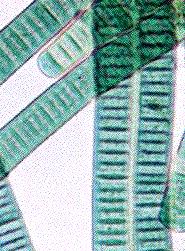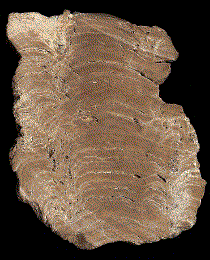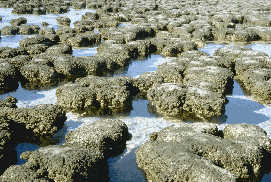The Earliest Known Life on Earth
The earliest evidence for life occurred during the
Archean Era, at least 3.5 b.y.a., and possibly as old
as 3.8 b.y.a. What were the conditions of Earth at this time?

- Sedimentary Rocks, 4.0 b.y.a., suggest oceans.
- NO Oxygen, but evidence of ancient carbonates, so CO2.
- Little to no continental crust. Maybe no dry land?
Introduction of the Cyanobacteria. Still around today, cyanobacteria are aquatic (live in water) and photosynthetic (can manufacture their own food). They are extremely small, usually unicellular, though can form large colonies. They have been identified in fossils more than 3.5 b.y.o.
 Cyanobacteria have been tremendously important in the shaping of
Earth's evolution. They are responsible for having brought about
it's Oxygen Atmosphere at
the end of the Archaean and
through out the Proterozoic
Eras.
Cyanobacteria have been tremendously important in the shaping of
Earth's evolution. They are responsible for having brought about
it's Oxygen Atmosphere at
the end of the Archaean and
through out the Proterozoic
Eras.
To the left is a layered Stromatolite, produced by the activity of
ancient cyanobacteria. The layers were produced as calcium
carbonate precipitated over the growing mat of bacterial filaments;
photosynthesis in the ancient bacteria depleted CO2
in the surrounding water, initiating the precipitation.
Bacterial colonies continue to grow upwards through the
sediment to form new layers. As this process occurred over and over
again, the layers
of sediment were created.

Such colonies of living cyanobacteria
in the form of stromatolites are found on earth (Shark's Bay,
W. Australia). This settled earlier debates about
whether the fossilized 3.5 b.y.o. structures were formed from
biological activity or not: They ARE.